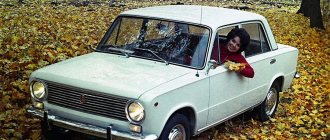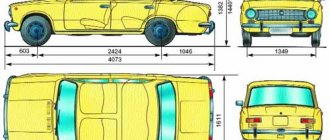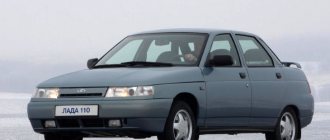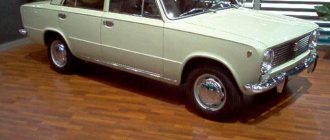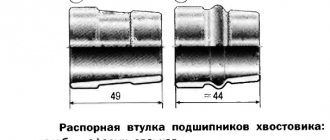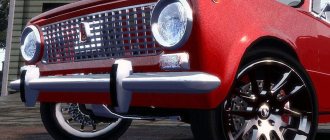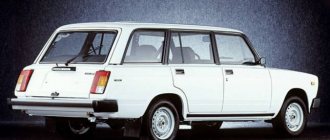History of the LADA (VAZ) brand
LADA is a brand owned by OJSC AVTOVAZ, the largest Russian manufacturer of passenger cars. Now the company is owned by the Renault-Nissan alliance and produces cars under the brands LADA, Renault, Nissan and Datsun. The main production and headquarters are located in the city of Tolyatti.
The Togliatti manufacturer was born in 1966, when the leadership of the USSR decided to build a large automobile plant, which was supposed to produce affordable cars for personal use. At that time in the Soviet Union there were only expensive cars in very limited quantities, which did not satisfy the demand from the population.
Before the start of construction, an agreement was concluded with the Italian automobile concern Fiat, which developed a technical project, supplied equipment and technical documentation, and also trained specialists. Many AVTOVAZ models were built on the basis of Fiat cars.
Construction of the plant started at the beginning of 1967 and was heralded as a Komsomol construction project. It was carried out at an accelerated pace; 844 machine-building plants of the Soviet Union and more than 900 plants from other countries were supplying equipment.
In 1970, the plant produced the first cars - the Zhiguli VAZ-2101, which repeated the design of the Fiat-124. However, the Soviet car was assembled from domestic components and, according to its designers, had more than 800 differences with its Italian counterpart. It received drum brakes instead of disc brakes, increased ground clearance, reinforced body and suspension. All this made the VAZ-2101 more suitable for use in the road conditions and temperatures of the Soviet republics.
The car was equipped with a carburetor gasoline engine with a more advanced overhead camshaft design. It was presented in two versions: 64- and 69-horsepower. The volume of the first was 1198 cm3, and the second - 1294 cm3. The maximum speed was 142 and 148 km/h, respectively, and the acceleration time from start to 100 km/h was 20 and 18 seconds.
The model required improvements, which were carried out by engineers as complaints were received. Therefore, it could no longer claim to be a cheap “people's car.” However, this did not prevent it from becoming popular in the USSR, where there was an acute shortage of vehicles.
The VAZ-2101, nicknamed the “penny”, became the founder of the “Classic” family and was produced until 1988. During this time, 4.85 million VAZ-2101 sedan units of all modifications were produced. For the production of this car, the Volzhsky Automobile Plant received the international Golden Mercury award.
VAZ-2101 (1970–1988)
In March 1971, the first stage of the Volzhsky Automobile Plant was put into operation, designed to produce 220,000 units annually. Already on July 16 of the same year, the 100,000th car rolled off the assembly line.
In 1972, the second model of AvtoVAZ, the VAZ-2102, was released. In fact, it was a copy of the “penny”, converted into a rear-wheel drive station wagon. It was called “the best friend of a summer resident” because of its practicality and spaciousness.
VAZ-2102 (1972–1985)
In the same year, production of a more powerful modification of the Zhiguli began - the VAZ-2103 model, which for export was called LADA 1500. It was already equipped with a 1.5-liter engine producing 77 hp. The maximum speed increased to 152 km/h. The new model reached “hundreds” in 16 seconds, which put it on the same level as Western competitors in the same class. In fact, the car was copied from the Italian Fiat 124 Speciale of 1968 with processing for use on the roads of the USSR.
The car also received a more comfortable, spacious and beautiful interior, a trunk trimmed with plastic and improved sound insulation. It was produced for 12 years, during which the plant produced 1,304,899 units of the model.
VAZ-2103 (1972–1984)
In 1976, the most popular model of the Tolyatti automobile plant, the VAZ-2106, was released, the prototype of which was the Italian Fiat 124 Speciale of 1972. The car replaced the VAZ-2103, and none of its creators expected such wild success among the public.
The VAZ-2106 was equipped with a 1.6-liter engine producing 75 hp, which allowed it to accelerate to 152 km/h.
In terms of appearance, the “six” received a new front fascia, rear trunk panel, different bumpers, side turn indicators, wheel caps, and ventilation grilles.
In the cabin, the upholstery and door armrests have changed, and the front seats have height-adjustable headrests.
In addition, the car was equipped with a steering column windshield washer switch, an alarm, a low brake fluid level indicator and a rheostat for the instrument panel lighting. More “advanced” versions received a radio, a red fog light and a heated rear window.
VAZ-2106 (1975–2005)
In 1977, one of the most successful AVTOVAZ cars appeared - Niva, VAZ-2121. This all-wheel drive SUV with a 1.6-liter engine and a frame chassis was successfully exported: more than 50% of the cars produced went abroad.
It was equipped with a four-speed manual gearbox, a locked center differential and a two-speed transfer case.
The Niva became a real sensation on the world market, arousing a desire among automotive industry leaders to create something similar. Success was ensured by innovative technical solutions (independent front suspension, all-metal monocoque body) and low price.
In 1978, the Niva was recognized as the best car in its class at the international exhibition in Brno. In 1980, the model received a gold medal at the Poznan International Fair.
The Volzhsky Automobile Plant decides to produce special versions of the VAZ-2121, the first of which are exported: a modification with a 1.3-liter engine and a right-hand drive version.
It is worth noting that in its homeland the Niva was not sold out as intensively as abroad. It was quite expensive both to purchase and to operate. At the same time, domestic consumers did not always need such a large car.
VAZ-2121 (1977)
In 1979, the VAZ-2105 was released, which was produced by the car plant for the longest time - until 2010. Its development took place as part of the modernization and preparation program for the second generation of rear-wheel drive cars of the brand.
It became the successor to the “kopek”, as well as the basis for the creation of the “luxury” VAZ-2107 sedan in 1981 and the VAZ-2104 station wagon in 1984.
VAZ-2105 (1979–2010)
In 1982, the last model of the “classics”, VAZ-2107, appeared. It is, in fact, a “luxury” modification of the VAZ-2105, which featured a more powerful engine, different bumpers and headlights, a radiator grille, a new hood shape, more comfortable front seats, an updated dashboard and the presence of cold air deflectors.
In the early 80s, it became obvious that front-wheel drive cars were the future. In addition, the car plant felt the need to change the design. As a result, in 1984, production of the three-door hatchback “Samara”, VAZ-2108, began.
The car and its five-door modification “Sputnik”, VAZ-2109, were distinguished by excellent dynamics and controllability, unpretentiousness to the quality of the road surface and high maximum speed.
The VAZ-2108 was equipped with a four-cylinder, four-stroke carburetor or injection engine with a volume of 1.1, 1.3 or 1.5 liters. This engine is specifically designed for use in a front-wheel drive vehicle.
VAZ-2108 (1984–2003)
The VAZ-2109 was a “family” variation of the G8, which was presented as a more respectable car.
The front-wheel drive new product certainly became an event in the domestic automobile market, but it had a number of disadvantages. In particular, it was not as cheap and easy to repair as the “classic”, it had less comfortable pedals and the oil receiver and engine crankcase quickly failed.
In 1990, the Tolyatti automaker released a four-door version of the family with a sedan body - VAZ-21099. It became the last model released before the collapse of the USSR.
The first car produced in the post-Soviet period was the “ten” - VAZ-2110. It was developed back in 1989, but the crisis years did not allow production to begin in 1992, as previously planned.
The VAZ-2110 began production only in 1995. It was equipped with one of two engine options: an 8-valve 1.5-liter with a power of 79 hp. or a 16-valve 1.6-liter engine developing 92 hp. The car was classified as the highest class in the Samara family, which could compete with Opel Astra, Audi 80 and Daewoo Nexia.
Over time, many modifications of the model were released, including station wagons, hatchbacks and coupes. Until the appearance of the LADA Priora, the “ten” was considered the most expensive and prestigious domestic car.
VAZ-2110 (1995–2007)
The successor to the VAZ-21099, the four-door sedan VAZ-2115, appears in 2007. The new product received a spoiler with an additional brake light on the trunk, bumpers painted in body color, streamlined sills, new taillights, door moldings and a more comfortable interior.
At first, the model was equipped with 1.5- and 1.6-liter carburetor engines, and since 2000 - a power unit with distributed fuel injection.
In 1998, the first Russian minivans appeared - VAZ-2120. The model was based on an extended platform, borrowed from the Niva, and was equipped with an all-wheel drive chassis, which helped to overcome the most difficult road conditions.
The car was produced in small series until 2008, when production was stopped due to low demand and unsatisfactory quality.
VAZ-2120 (1998–2008)
In 1993, the development of a new car called Lada-Kalina began. The design continued for quite a long time, in 1999 the first prototype debuted in a hatchback body, a year later - a sedan, and in 2001 - a station wagon.
The first generation of the model was produced from November 18, 2004. Since July 2007, LADA Kalina received a new 16-valve 1.4-liter engine, and since September - an ABS system.
The model was constantly modernized. So, in 2010, a version with a black “basalt” interior and a standard audio system appeared.
On May 1, 2011, AVTOVAZ announced the cessation of production of the LADA Kalina sedan, which was replaced by the budget LADA Granta.
LADA Kalina (2004)
In 2008, the Renault-Nissan Corporation bought a 25% stake in AVTOVAZ OJSC. The company met the next year with a bevy of financial problems, causing production to be cut by almost half.
The auto company needed government support, and it allocated 25 billion rubles as an interest-free loan, and also included the entire AVTOVAZ model range in the state program for subsidizing car loan rates.
In September, mass layoffs occurred at the enterprise, and the Ministry of Industry and Trade of the Russian Federation stated that the automobile plant was in a pre-bankruptcy state, and therefore state support was inappropriate. It was proposed to cut around 50,000 employees.
In November, Renault put forward a proposal to organize the production of LADA, Renault and Nissan cars based on the B0 platform at the Volzhsky Automobile Plant. The help of the French contributed to the enterprise receiving additional funding from the government. This helped overcome the financial crisis and even make a profit in 2010.
On December 12, 2012, the creation of a joint venture between the Renault-Nissan alliance and the state corporation Russian Technologies was announced. By the end of 2013, the new joint venture owned 76.25% of the shares of AVTOVAZ OJSC.
On June 18, 2014, Renault-Nissan increased its share in the share capital of AVTOVAZ to 67.13%.
In the current LADA portfolio, the Priora sedan model appeared in 2007. The following year, a hatchback car was released, and in 2009, a station wagon. The car is equipped with an 8-valve engine producing 81 hp. or 16-valve 98 hp.
It is the successor to the VAZ-2110, representing its restyled version. In appearance, the front and rear fenders, trunk lid and hood, bumpers, lighting equipment with fog lights, alloy wheels, and radiator trim have changed.
The interior was developed jointly with the Italian studio Carcerano. There is a new front panel, a silver console trim, a new armrest with two niches, better upholstery, a driver airbag, and improved sound insulation.
LADA Priora (2007)
On May 16, 2011, serial production of LADA Granta started. This car was developed based on the Kalina model. In March 2013, a modification with a liftback body appeared, which, among other things, differed in the shape of the rear side doors, the front bumper and the location of the rear license plate.
The model is equipped with a 1.6-liter petrol engine with distributor injection and three power options - 87, 98 and 106 hp.
As soon as the car went on sale, it caused a rush of demand from buyers. The queues for the new product stretched until March 2012.
LADA Granta became the first car of the Togliatti Automobile Plant, which was equipped with an automatic transmission as standard - a four-speed transmission from the Japanese company Jatco.
LADA Granta (2011)
In 2012, the LADA Largus appeared, developed jointly with Renault on the Logan platform. The car is produced in station wagon, high-capacity station wagon and cargo van versions. In this case, the passenger version can be five or seven seats.
LADA Largus (2012)
Currently, the LADA model range includes five families of cars: Largus station wagon, Granta sedan and liftback, Priora sedan, hatchback and station wagon, Kalina hatchback and station wagon, as well as three- and five-door 4x4 models. Separately, it is worth noting that the cross-versions of the popular station wagons Largus and Kalina, as well as the 4x4 Urban adapted for the city, were added to the brand’s model line at the turn of 2014–2015. All manufactured vehicles comply with international environmental standards Euro-4, and those exported to Europe comply with Euro-5.
LADA Kalina Cross, Largus Cross, 4×4 Urban
In 2014, the automaker occupied 17% of the Russian passenger car market. Production, in addition to the Tolyatti automobile plant, is organized in the Russian cities of Syzran, Izhevsk, Serpukhov and Naberezhnye Chelny, in the Ukrainian cities of Lutsk, Kherson, Zaporozhye, Kremenchug, as well as in Ecuador, Egypt, Uruguay.
In Russia, production of rear-wheel drive Zhiguli cars has been discontinued, which lasted for 42 years.
Serial production of the famous “penny”, the VAZ-2101 sedan under a license from Fiat, began in the USSR in April 1970. And on September 17, 2012, in a country called the Russian Federation, the last VAZ-2104 station wagon, built on the same Fiat platform, rolled off the assembly line of the IzhAvto plant. The Four lasted the longest in the classic family - the last VAZ-2107 sedans left the IzhAvto assembly line back in April.
And now - goodbye, the Fiat legacy is actually half a century old! After all, the original Fiat 124, on the basis of which the VAZ-2101 was built, was developed in Turin in the early 60s, debuted in Italy in the spring of 1966, and in the fall became the Car of 1967, receiving the prestigious and new at that time COTY, Car of the award Year 1967. The USSR was then experiencing an acute shortage of passenger cars, and in May 1966, the Ministry of Automotive Industry and the FIAT concern signed a protocol on scientific and technical cooperation, and later an agreement on the construction of a car plant based on an Italian project. VAZ was built throughout the country in the former Stavropol-on-Volga, which was renamed in honor of the Italian communist Palmiro Togliatti back in 1964. The appearance of the Zhiguli spurred the development of the entire Soviet industry: mass production of antifreeze, working fluid for disc brakes, modern oils, radial tires and high-octane gasoline began. VAZ reached its design capacity of 660 thousand cars per year already in 1974, and in the late seventies, almost half of the cars were exported!
VAZ-2101 first releases
Surprisingly, the “classics” were not killed by the appearance of front-wheel drive VAZ models, the massive influx of foreign cars, or the introduction of environmental standards. The last surge in demand in 2010 was provoked by a program for recycling junk cars - then 138 thousand Zhiguli were sold. But with the completion of the state project, the demand for “classics” fell three times - from 17 to six thousand cars per month at the end of 2011. In August of the same year, the assembly of the “classics” was completely transferred to Izhevsk, although vehicle kits were still produced in Tolyatti. In recent months, the production of “fours” remained at the level of only one and a half thousand cars per month, and the last white car went to the IzhAvto museum. Along with the “four”, the “heeled” Izh-27175, a hybrid of a Zhiguli and an old van based on the Izhevsk Oda, also retired. Over seven years, 37,500 of these machines saw the light of day.
Late VAZ-2104 produced by IzhAvto
AvtoVAZ thought at least twice about sending the “classic” into retirement. And they even developed versions of successor cars on a modernized rear-wheel drive chassis, but both the “neoclassic” VAZ-2151 in 2002 and the surgically rejuvenated “seven” VAZ-2107M that appeared next turned out to be economically unviable. As a result, such projects were given up and the Zhiguli of the classic layout was replaced by the front-wheel drive Granta - much more modern and safe.
In total, since 1970, 17.6 million Zhiguli cars have seen the light of day, including cars assembled from VAZ vehicle kits in Ukraine and Egypt. This is the second result in the history of the global automobile industry! Ahead are only the German Beetle, the Volkswagen Beetle with a result of 21.5 million units, and behind is the legendary Ford T, which sold 16.5 million units. And if we count together those cars based on the Fiat 124 model, which, in addition to Italy and Russia, were also produced in Spain, Bulgaria, Turkey, India, Morocco and even South Korea, it turns out that since 1966, 20 have been produced worldwide. 5 million such cars. You can also add the result of the Fiat 125 model with a spring rear suspension and a slightly stretched wheelbase - 2 million 240 thousand of these cars were produced in Italy, Poland and Argentina alone, and they were assembled in small series in other developing countries. And then FIAT will rightly be considered the developer of the most massive design in the history of a car - more than 22.7 million copies!
And all thanks to the USSR, and then Russia. And if in the rest of the world the last “derivative” of the Fiat 124, the Indian Premier 118NE, stopped being produced in 2001, then the Russian “classic” lasted another eleven years. Moreover, if the production of Zhiguli cars in Ukraine was curtailed in 2011, then the supply of vehicle kits to Cairo... continues! Over the eight months of 2012, 4,700 sets were shipped to the Egyptian Suzuki plant, where the 7s are assembled, and there is an order for next year. VAZ workers report that “the issue of continuing supplies is being worked out.” However, according to the law on the protection of consumer rights, AvtoVAZ will produce spare parts for the “classic” for another 8-10 years.
Production of Fiat 124/125 family cars by country
The freed up capacity in Izhevsk, where Zhiguli cars have been made since 2001, will now be used to increase Granta production. In fact, the “four” were kept on the assembly line until September precisely in order not to leave employees without work while the “grant” assembly line was being set up. Granta assembly has now been switched to a two-shift mode: by the end of the year, production of the model should reach the level of 8,000 cars per month.
Unlike the “seven,” the “four” and the “heel” were left without heirs. There is no other station wagon priced at about 220 thousand rubles on the Russian market and is not expected. Kalina station wagon now costs at least 298,900 rubles, and Largus costs 376 thousand rubles.
